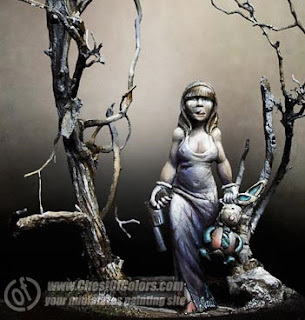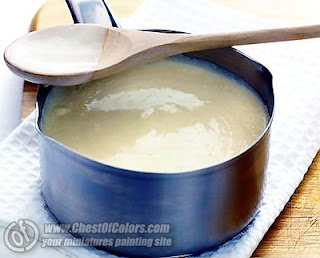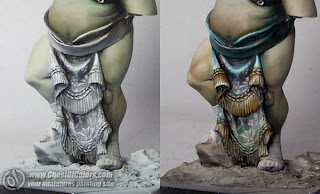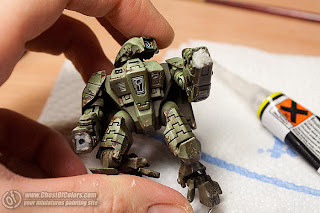I keep receiving mail and private messages from hobbyists, most of them very kind and encouraging. Thanks for this! Some people ask me questions about my painting methods or techniques. Sometimes I don't have enough time to respond to all of them individually, but some of my answers could be useful to more people than only the person who asked the question.
I will be trying to publish such answers on this blog.
So here is one of such answers - expanded with some more information and served for your pleasure :)"How to build chiaroscuro with glazes?"
Dostaję trochę poczty i prywatnych wiadomości od hobbistów, większość bardzo miła i motywująca. Dziękuję Wam za to! Niektórzy pytają o moje metody i techniki malarskie. Czasem nie udaje mi się znaleźć dość czasu żeby każdemu odpisać indywidualnie, ale niektóre z moich odpowiedzi mogłyby się przydać gronu szerszemu niż tylko osobie, na której pytanie odpowiadam.
Postaram się prezentować takie odpowiedzi na tym blogu.
Oto jedna z takich odpowiedzi - rozszerzona o dodatkowe informacje i podana dla Waszej przyjemności :)
It can be done this way:
Cover the primer with your base color highlighted to some 70% of the final highlight you want to apply.
Do it in a smooth and even way, with a few layers (the more layers you apply and the thinner they are, the smoother surface you will have for applying your chiaroscuro, and it makes painting much easier).
When you achieve a smooth surface without smudges, you have a choice: you can highlight to your final color first and shade it later, or do it the other way around.
It's more convenient for me to shade first and add my highlights in the later stages of painting. This makes me feel free to build up shadows as deep as I want, and I feel this is the crucial factor in building the ambience of the miniature.
Można to zrobić na przykład tak:
Podkład pokryj kolorem bazowym rozjaśnionym w 70% (w stosunku do ostatecznego rozjaśnienia jakie zamierzasz nałożyć).
Zrób to równomiernie, kilkoma warstwami (im więcej warstw i są one rzadsze, tym gładszą powierzchnię będziesz miał przy rozkładaniu światłocienia, a to upraszcza malowanie).
Kiedy uzyskasz bezsmugową powierzchnię, masz wybór - możesz najpierw rozjaśnić do ostatecznego efektu a potem przyciemniać, albo odwrotnie.
Mnie wygodniej jest najpierw dążyć do cienia, a na końcu ostatecznie rozświetlać. Dzięki temu czuję się nieograniczona w budowaniu cienia, który moim zdaniem jest głównym czynnikiem budującym nastrój.
Zrób to równomiernie, kilkoma warstwami (im więcej warstw i są one rzadsze, tym gładszą powierzchnię będziesz miał przy rozkładaniu światłocienia, a to upraszcza malowanie).
Kiedy uzyskasz bezsmugową powierzchnię, masz wybór - możesz najpierw rozjaśnić do ostatecznego efektu a potem przyciemniać, albo odwrotnie.
Mnie wygodniej jest najpierw dążyć do cienia, a na końcu ostatecznie rozświetlać. Dzięki temu czuję się nieograniczona w budowaniu cienia, który moim zdaniem jest głównym czynnikiem budującym nastrój.
When shadows are created and the ambience of the miniature is definied, creation of final lights is the cherry on top of it all. It's much easier for me to see where it's best to focus the viewer's attention with stronger light when most of my work is already done.
Additional suggestion:
Start your shading of the base color (I mean the one highlighted to 70%) with with gradual rebuilding of saturation of the color which was initially highlighted.
Only when the pure base color is applied you can start adding shading colors to it. Cover smaller and smaller areas with subsequent layers of darker and darker colors, and it will build the final shadows :)
Gdy już mam cienie i stworzony klimat, "wisienką na kremie" jest ostateczne oświetlenie. Łatwiej jest mi dostrzec gdzie najlepiej przyciągnąć wzrok mocniejszym światłem, gdy większość roboty jest już wykonana.
Dodatkowa sugestia:
Na kolorze bazowym (czyli tym rozjaśnionym w 70%) cieniowanie rozpoczynaj od stopniowego odzyskiwania nasycenia koloru, który nakładałeś rozjaśniony.
Dopiero po nałożeniu na figurkę 100% czystego koloru, zacznij dokładać do niego kolor cieniujący. Pokrywaj stopniowo coraz mniejsze powierzchnie, coraz to ciemniejszym kolorem, a uzyskasz w ten sposób ostateczne zacienienie :)
Never start shading with the color of ultimate shadows. This would reduce your chances of creating smooth transitions of colors.
A cook would say that it's just like with bechamel sauce ;) if you don't add colors in tiny steps, you won't avoid streaky finish, just like you wouldn't be able to avoid lumps in your sauce ;)
So remember to apply any changes of colors or transitions gradually.
Nigdy nie zaczynaj cieniowania od ostatecznego koloru cienia. Przez to zmniejszasz swoje szanse na gładkie przejścia.
Kucharz powiedziałby Ci, że to tak samo jak z sosem beszamelowym ;) jeśli nie będziesz stopniowo małymi kroczkami dokładał kolorów, to nie unikniesz smug, tak jak w sosie beszamelowym grudek ;)
Wszelkie zmiany kolorystyczne czy przejścia wprowadzaj zatem stopniowo.
Glazing is a good method to learn shading - it's pretty radical because it doesn't forgive the smallest mistakes and makes them stand out in the final effect ;) but when you make it through this, there will be nothing more to fear!
Remember about the right way of holding the paintbrush against the surface and not leaving too much liquid on the brush (I don't remember if I have already written about wiping the excess of paint off - for example against a palm. Have I?)
Laserunek to dobra metoda na uczenie się cieniowania - dość radykalna bo nie wybacza najmniejszego potknięcia i wytyka je nawet w efekcie końcowym ;) ale jak przez to przebrniesz, to nic Ci nie będzie straszne.
Pamiętaj o dobrym ustawieniu pędzla w stosunku do powierzchni i o tym, żeby nie zostawiać za dużo płynu na pędzlu (Nie pamiętam, czy pisałam Ci o obcieraniu nadmiaru farby np. o dłoń. Pisałam?)
Pamiętaj o dobrym ustawieniu pędzla w stosunku do powierzchni i o tym, żeby nie zostawiać za dużo płynu na pędzlu (Nie pamiętam, czy pisałam Ci o obcieraniu nadmiaru farby np. o dłoń. Pisałam?)
Most likely you won't be able to succeed with only one model messed up ;) but it only spices the future success up a bit. :-D
But just in case let me tell you it can be done in a different way too...
Another method:
When I want to achieve very deep shadows, I paint the model in a monochrome way first. For example I paint the model in black and white only, and only then apply colors on top of this. It only requires some intuition about how much shadow should be placed and where to place it to be able to squeeze the planned colors over the transition later.... I often feel it's the easier method for me, but you have to find out what is more enjoyable and easier for you.
This method of shading doesn't reduce saturation of paints because you apply the same color over the whole surface, without mixing it with black or white. Get it?
For this sequence of painting I find transparent paints, washes and inks most useful. But of course it all depends on the effect you want to achieve.
Pewnie nie skończy się na jednym skopanym modelu ;) ale to dodaje tylko smaczku późniejszemu sukcesowi. :-D
Ale na wszelki wypadek uprzedzę, że można jeszcze inaczej...
Ale na wszelki wypadek uprzedzę, że można jeszcze inaczej...
II metoda:
Kiedy chcę osiągnąć bardzo głęboki cień, to maluję najpierw monochromatycznie, np. biel cieniuję do czerni, a dopiero potem dokładam barwy. Do tego trzeba jedynie umieć wyczuć ile cienia i gdzie umieścić, tak by pomiędzy zmieścić zaplanowany kolor... tak mi się nawet łatwiej maluje, ale Ty sam uznaj co sprawia Ci większą łatwość i przyjemność.
Taka metoda cieniowania nie tłumi soczystości barw, bo taką barwę nakładasz na powierzchnię w czystej postaci - nie stłumionej przez zmieszanie z czernią, czy bielą. Rozumiesz?
Kiedy chcę osiągnąć bardzo głęboki cień, to maluję najpierw monochromatycznie, np. biel cieniuję do czerni, a dopiero potem dokładam barwy. Do tego trzeba jedynie umieć wyczuć ile cienia i gdzie umieścić, tak by pomiędzy zmieścić zaplanowany kolor... tak mi się nawet łatwiej maluje, ale Ty sam uznaj co sprawia Ci większą łatwość i przyjemność.
Taka metoda cieniowania nie tłumi soczystości barw, bo taką barwę nakładasz na powierzchnię w czystej postaci - nie stłumionej przez zmieszanie z czernią, czy bielą. Rozumiesz?
Przy tej kolejności malowania najlepiej sprawdzają się farby transparentne, inki i washe. Wszystko zależy jaki efekt chcesz osiągnąć ...
For example that's how I painted "Peace & Love" - you can read about it in Game Forces #21.
Generally I wanted to achieve the look of muted colors so I used the first technique of glazing for this model, but some parts of it - where I wanted to create a focus for the viewer's attention - I applied colors in the last stage over a monochrome underpainting.
That's how I tried to control your minds ;P I attempted to emphasize the elements which were most important for me and direct your attention there.
Tak na przykład malowałam "Peace & Love" - możecie przeczytać o tym artykuł w 21. wydaniu Game Forces.
Generalnie chciałam osiągnąć efekt stłumionych barw i malowałam go tą pierwszą techniką laserunku, ale miejscami - gdy chcę przykuć spojrzenie obserwatora - nakładam barwę właśnie jako ostatnią na warstwie monochromatycznej.
Tak to podejmuję próbę przejęcia kontroli nad Waszymi umysłami ;P Staram się uwydatnić elementy które były dla mnie najistotniejsze i tam pokierować Wasz wzrok.
And what is your experience with chiaroscuro? How do you achieve it in your works? Do you also use glazes for this purpose, or do you prefer other methods of blending?
A jakie są Wasze doświadczenia ze światłocieniem? Jak go budujecie w swoich pracach? Czy także używacie w tym celu laserunków, czy wolicie jakieś inne metody?
















































